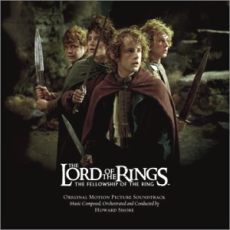|
(30 November 2001) For many people Tolkien’s epic novel The Lord of the Rings may not have needed a movie adaptation. Tolkien’s language and imagery is so vivid, images form in the mind quickly. The flawed 1978 movie adaption by Ralph Bakshi did little to change that notion, but did feature a rousing score by Leonard Rosenman. Our interest in the soundtrack stems initially from vocal contributions by Enya. Entitled Music From The Motion Picture Lord Of The Rings--The Fellowship Of The Ring (Reprise/New Line (USA) 2-48810 / 48238-RE-1), the 18-track CD is produced by Howard Shorte and Suzana Perle; two of the tracks are produced and engineered by Nicky Ryan. Hopes are high for the new three-part movie adaptation by Peter Jackson. At this time, the score for the first movie The Fellowship of the Ring has been released. The score was written by Howard Shore and performed by the London Philharmonic Orchestra, the New Zealand Symphony Orchestra, the London Voices and several guest performers. Tolkien’s novel evokes many melodies; his novel is littered with songs and instruments and the story’s strong moods easily evoke music. In this context, Howard Shore’s score is both beautiful and appropriate. The Lord of the Rings is often described as an epic, and Shore has written appropriate sweeping pieces, such as "The Black Rider"and "The Bridge Of Khazad Dum," evoke grand events and powerful emotions. On the other hand, pieces such as "Concerning Hobbits" and "At The Sign Of The Prancing Pony" are far more light and subtle, having a truly British feel--not coincidental, as Tolkien modeled the Hobbits’ home in the Shire on the English countryside.Other motifs of the story, such as the quiet beauty of the elves and the darkness of the evil forces are just as powerfully rendered in music. The score employs choral pieces to great effect, oftentimes with the lyrics sung in one of Tolkien’s Elfin languages. The effect of this is similar to John Williams’ use of a chorus in the score for Star Wars Episode I - The Phantom Menace. The choir establishes a strong atmosphere while not turning the score into a musical. The score uses three solo vocalists and uses them well. Elizabeth Fraser, best known for her incredible vocal performances as part of the Cockteau Twins, sings the haunting "Lament for Gandalf." This song is part of the stand-out piece "Lothlorien," which through its shifting melodies, its ethereal female chorus, and its oriental instrumentation truly provides an otherworldly feel that perfectly matches Tolkien’s description of Lothlorien. Young singer Edward Ross brings his pure choir-boy voice to "In Dreams." However, most attention will most likely go to the contributions of Irish singer Enya. Enya contributes to two songs, "Aniron" and "May It Be," both of which she composed herself. Of these two, "Aniron" is the stronger song. It has a simple yet strong melody and the lyrics are powerfully sung. Enya’s throaty voice reminds one of her vocal on the song "Exile" from the album Watermark. Supported by a sparse string arrangement and followed by a powerful rendition of the score’s main fellowship theme, this song is well integrated in the overall score. The song "May It Be" is more reminiscent of the ballads on Enya’s A Day Without Rain album. Melodically it is less interesting than "Aniron," but the lyrics serve the moment in the story at which the movie ends well. Overall, the music for The Fellowship of the Ring is a varied, beautiful, and grand movie score which can easily stand on its own as an impressive musical work. You can read further  reviews, hear soundbitesand order the album from amazon.comhere. Fans of orchestral movie scores, of Tolkien’s books, and of the impressive vocals of many of the artists featured on Musical Discoveries will find much to enjoy here.--Paul van Vliet reviews, hear soundbitesand order the album from amazon.comhere. Fans of orchestral movie scores, of Tolkien’s books, and of the impressive vocals of many of the artists featured on Musical Discoveries will find much to enjoy here.--Paul van Vliet
|





